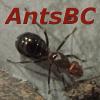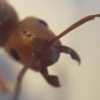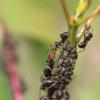- Formiculture.com
- Forums
- Gallery
- Members
- Member Map
- Chat

Queen ant ID please Maine North America 7/5/2019
Started By
AdamL
, Jul 5 2019 7:54 AM
18 replies to this topic
#1
 Offline
-
Posted July 5 2019 - 7:54 AM
Offline
-
Posted July 5 2019 - 7:54 AM
I found this ant I'm am pretty sure it is a queen amt just want to confirm and find out what species it is.
1.I found it in Lovell Maine North America
2.I found it on 7/4/2019
3.I found it wandering around a wood plank in the ground next to a small forest
4.It is 10/16 of a inch long
5.Black body but dark red thorax and legs
6. It has big mandabels
7.It is calm until I move it around a little
I found it in the corner where the wood meets
http://imgur.com/gallery/7ePe5aT
The top view of the ant
http://imgur.com/gallery/qr0Lsjc
The side view of the ant
http://imgur.com/gallery/Ox3z3l7
#2
 Offline
-
Posted July 5 2019 - 8:18 AM
Offline
-
Posted July 5 2019 - 8:18 AM
that is a queen. idk what species
#3
 Offline
-
Posted July 5 2019 - 9:54 AM
Offline
-
Posted July 5 2019 - 9:54 AM
Camponotus chromaiodes queen.
#5
 Offline
-
Posted July 5 2019 - 3:07 PM
Offline
-
Posted July 5 2019 - 3:07 PM
rbarreto the bottom of her thorax is more red that black but her gaster is really black not dark red.
Edited by AdamL, July 5 2019 - 3:14 PM.
- rbarreto likes this
#6
 Offline
-
Posted July 5 2019 - 4:05 PM
Offline
-
Posted July 5 2019 - 4:05 PM
10/16” = 16mm
Edited by Martialis, July 5 2019 - 5:59 PM.
Spoiler
#7
 Offline
-
Posted July 5 2019 - 5:38 PM
Offline
-
Posted July 5 2019 - 5:38 PM
10/16” = 16mm
C. herculaneus is 11mm at the high end. This is C. chromaiodes.
The AntWiki page of Camponotus herculeanus says 13-16 millimeters for queens, and this 1855 paper by Mayr says 15-17 millimeters.
#8
 Offline
-
Posted July 5 2019 - 5:58 PM
Offline
-
Posted July 5 2019 - 5:58 PM
10/16” = 16mm
C. herculaneus is 11mm at the high end. This is C. chromaiodes.
The AntWiki page of Camponotus herculeanus says 13-16 millimeters for queens, and this 1855 paper by Mayr says 15-17 millimeters.
Oops. I thought they were Myrmentoma—I guess I was wrong.
Spoiler
#9
 Offline
-
Posted July 6 2019 - 2:07 AM
Offline
-
Posted July 6 2019 - 2:07 AM
#10
 Offline
-
Posted July 6 2019 - 5:30 AM
Offline
-
Posted July 6 2019 - 5:30 AM
So based off of what your saying it is a c.herculeanus
#11
 Offline
-
Posted July 6 2019 - 1:59 PM
Offline
-
Posted July 6 2019 - 1:59 PM
rbarreto the bottom of her thorax is more red that black but her gaster is really black not dark red.
Then I'm going to go with C. herculeanus.
Colour is not a accurate way to tell apart species, and this case is no exception. Camponotus chromaiodes vary in colour; not all queens have the routine red on the gaster, (Example). Camponotus herculeanus vary too; I have seen queens with the usual black thorax with the red underside, to queens with red, C. novaeboracensis - like markings on their thorax's. You cannot base an identification off of colour alone.
So based off of what your saying it is a c.herculeanus
No, I would not say that. Camponotus herculeanus queens are usually more slender looking, although that isn't the main reason I believe this is C. chromaiodes instead. The main reason being, in this photo, I think I can see displaced pubescence on the gaster, which suggests this is C. chromaiodes. Camponotus herculeanus queens have organized, golden pubescence lines on their gaster segments, while C. chromaiodes' pubescence can be more scattered and disorganized. The photo of this specimen's gaster also seems to be dull/matte like, which would definitely more comfortably align with C. chromaiodes. C. herculeanus queens are shiny, while C. chromaiodes queens are more dull in pigment, (Like C. modoc).
The photo's aren't really good enough to lean either way; we're going to need better photos. But, as far as body structure, pigment, and pubescence placement is concerned, I still think this is C. chromaiodes.
Edited by AntsBC, July 6 2019 - 2:10 PM.
- Canadian anter and TennesseeAnts like this
#12
 Offline
-
Posted July 6 2019 - 3:14 PM
Offline
-
Posted July 6 2019 - 3:14 PM
rbarreto the bottom of her thorax is more red that black but her gaster is really black not dark red.
Then I'm going to go with C. herculeanus.
Colour is not a accurate way to tell apart species, and this case is no exception. Camponotus chromaiodes vary in colour; not all queens have the routine red on the gaster, (Example). Camponotus herculeanus vary too; I have seen queens with the usual black thorax with the red underside, to queens with red, C. novaeboracensis - like markings on their thorax's. You cannot base an identification off of colour alone.
So based off of what your saying it is a c.herculeanus
No, I would not say that. Camponotus herculeanus queens are usually more slender looking, although that isn't the main reason I believe this is C. chromaiodes instead. The main reason being, in this photo, I think I can see displaced pubescence on the gaster, which suggests this is C. chromaiodes. Camponotus herculeanus queens have organized, golden pubescence lines on their gaster segments, while C. chromaiodes' pubescence can be more scattered and disorganized. The photo of this specimen's gaster also seems to be dull/matte like, which would definitely more comfortably align with C. chromaiodes. C. herculeanus queens are shiny, while C. chromaiodes queens are more dull in pigment, (Like C. modoc).
The photo's aren't really good enough to lean either way; we're going to need better photos. But, as far as body structure, pigment, and pubescence placement is concerned, I still think this is C. chromaiodes.
This case, really, is an exception. You will not find a Camponotus herculeanus queen with a bright red, almost golden coloration on her legs and/or gaster in the same fashion which is seen in Camponotus chromaiodes queens. In this thread, if we do not have clear pictures (with better lighting), then we will be unable to determine the species and it is up to the Adam to determine this.
Along with this, antmaps.org shows that this C. chromaiodes is a much less documented ant in Maine. I also highly doubt you can gain any knowledge of the pubescence from looking at the dorsal view or profile view due to the pictures not having the lighting required or being a little too blurry. Camponotus queens often all are "slender looking", seen in the profile view of many queens which are idle.
- Aaron567 likes this
Ant Keeping & Ethology Discord - 2000+ Members and growing
Statesideants.com - order live ants legally in the US
#13
 Offline
-
Posted July 6 2019 - 3:50 PM
Offline
-
Posted July 6 2019 - 3:50 PM
rbarreto the bottom of her thorax is more red that black but her gaster is really black not dark red.
Then I'm going to go with C. herculeanus.
Colour is not a accurate way to tell apart species, and this case is no exception. Camponotus chromaiodes vary in colour; not all queens have the routine red on the gaster, (Example). Camponotus herculeanus vary too; I have seen queens with the usual black thorax with the red underside, to queens with red, C. novaeboracensis - like markings on their thorax's. You cannot base an identification off of colour alone.
So based off of what your saying it is a c.herculeanus
No, I would not say that. Camponotus herculeanus queens are usually more slender looking, although that isn't the main reason I believe this is C. chromaiodes instead. The main reason being, in this photo, I think I can see displaced pubescence on the gaster, which suggests this is C. chromaiodes. Camponotus herculeanus queens have organized, golden pubescence lines on their gaster segments, while C. chromaiodes' pubescence can be more scattered and disorganized. The photo of this specimen's gaster also seems to be dull/matte like, which would definitely more comfortably align with C. chromaiodes. C. herculeanus queens are shiny, while C. chromaiodes queens are more dull in pigment, (Like C. modoc).
The photo's aren't really good enough to lean either way; we're going to need better photos. But, as far as body structure, pigment, and pubescence placement is concerned, I still think this is C. chromaiodes.
Woops I messed that up. What I was trying to say was that if there was red on the upper portion of the gaster then this queen would have to be C. chromaiodes, not that not having red would mean it has to be C. herculeanus. My instinct is that she is C. herculeanus just based on the way she looks. I Could definitely be wrong though.
@AdamL I suggest you google image search what the queens look like. There are some pretty good pictures there.
Edited by rbarreto, July 6 2019 - 3:53 PM.
My journal featuring most of my ants.
My other journal featuring Formica Bradleyi.
Check our my store here!
#14
 Offline
-
Posted July 6 2019 - 4:05 PM
Offline
-
Posted July 6 2019 - 4:05 PM
I looked up both Camponotus chromaiodes Camponotus herculeanus and to me it looks like C.herculeanus but there pretty much the same.
#15
 Offline
-
Posted July 6 2019 - 6:57 PM
Offline
-
Posted July 6 2019 - 6:57 PM
I looked up both Camponotus chromaiodes Camponotus herculeanus and to me it looks like C.herculeanus but there pretty much the same.
C. chromaioides tends to have red on the anterior (front) half of the gaster and has dense golden hairs on the gaster compared to the more sparse and shiny gaster of C. herculeanus. It should be easy to tell in real life with better lighting than the photos. In my opinion it's probably C. herculeanus since in the dorsal pic there is no red on the gaster and it appears to be too shiny for C. chromaioides (Light is reflecting off of the gaster, if there was hair the density of chromaioides should at least leave a goldish sheen.
#16
 Offline
-
Posted July 7 2019 - 3:40 AM
Offline
-
Posted July 7 2019 - 3:40 AM
Ok ill try to get some better photos
#17
 Offline
-
Posted July 7 2019 - 6:05 AM
Offline
-
Posted July 7 2019 - 6:05 AM
C. chromaioides tends to have red on the anterior (front) half of the gaster and has dense golden hairs on the gaster compared to the more sparse and shiny gaster of C. herculeanus. It should be easy to tell in real life with better lighting than the photos. In my opinion it's probably C. herculeanus since in the dorsal pic there is no red on the gaster and it appears to be too shiny for C. chromaioides (Light is reflecting off of the gaster, if there was hair the density of chromaioides should at least leave a goldish sheen.I looked up both Camponotus chromaiodes Camponotus herculeanus and to me it looks like C.herculeanus but there pretty much the same.
I have Camponotus chromaiodes queens with no red on the gaster, and lots of dark red on the mesosoma and legs, while having black workers with a small tint of red on their legs.
- AntsBC likes this
My Main Journal | My Neivamyrmex Journal | My Ant Adoption | My YouTube
Join the TennesseeAnts Discord Server! https://discord.gg/JbKwPgs
#18
 Offline
-
Posted July 7 2019 - 3:27 PM
Offline
-
Posted July 7 2019 - 3:27 PM
Ok ill try to get some better photos
Try to embed your photos next time. There's a thread on how to do it.
- TennesseeAnts likes this
#19
 Offline
-
Posted July 7 2019 - 4:12 PM
Offline
-
Posted July 7 2019 - 4:12 PM
- Martialis and TennesseeAnts like this
1 user(s) are reading this topic
0 members, 1 guests, 0 anonymous users























